Maudsley
Hospital
Denmark Hill, Camberwell, SE5 8AZ
Medical
dates:
Medical
character:
Psychiatric
In February 1908 the LCC
received £30,000 from the psychiatrist Dr Henry Maudsley
(1835-1918) towards the cost of establishing a specialist hospital for
the early treatment of recoverable mental disease (another
£10,000 was added later by his bequest). Such a hospital
should be small, centrally located and have an Out-Patients Department.
It should also include facilities for teaching and research.
The estimated cost for the hospital was £60,000, half of which the LCC agreed to pay, stipulating that it should not be more than 4 miles from Charing Cross to make it accessible to both patients and students.
Practical and legal difficulties delayed the purchase of a suitable site, but in April 1911 a plot of land in Camberwell was chosen, opposite the newly opened King's College Hospital. Construction work began in October 1913. Excluding the purchase of the site, the cost per bed was estimated at £400, expensive compared to the cost of £260 in a 2000-bedded asylum. The buildings were completed in 1915, when costs had risen to £69,750. The Hospital had six wards - two for assessment and four for treatment - which housed 144 beds (rather than the 108 originally planned); the cost per bed had increased to £484.
In 1915 in a private Act of Parliament the LCC obtained powers to allow it to defray the cost of treating voluntary patients at the Hospital by charging richer patients (this privilege was only granted to licensed houses and registered hospitals; it had never before been given to any mental hospital provided by a local authority. Later, the Mental Treatment Act, 1930, enabled this).
However, before the Hospital could officially open, it was requisitioned by the government for the duration of WW1. It became the Maudsley Military Hospital, the Neurological Section of the 4th London General Hospital, and a War Office clearing hospital and treatment centre for soldiers diagnosed with shell shock and war psychoneuroses. All patients labelled at the base hospitals as 'neurological', i.e. unwounded, but suffering from neurasthenia, the functional paralyses, hysteria or the milder psychoses, were transferred here. They received a short preliminary course of treatment, after which many recovered rapidly and in due course could return to light duty. The more serious cases were transferred to other hospitals provided for the purpose, such as the Springfield War Hospital in Wandsworth. In the event of a patient becoming insane, he was transferred to D Block at Netley Hospital or to the Napsbury War Hospital.
In 1916 the King and Queen visited the Hospital and expressed themselves as well pleased with the arrangements and accommodation for the treatment and comfort of the troops. By 1917 it accommodated 185 soldiers and 18 officers with shell-shock, neurasthenia or acute mental disorder. A large hut was constructed in the grounds for use as a workshop. Carpentry, cabinet-making and metal work were taught as a form of treatment by useful diversion of convalescent patients' minds. The hut, its equipment and its upkeep was paid for by Lady Henry Bentinck.
In 1918 one of the wards was painted in a new colour scheme - apple-blossom pink and mauve - designed by Mr Hugh Kemp-Prosser to alleviate the stresses of shell shock and neurasthenia. The use of 'spring' colours to provide therapeutic surroundings had proved successful at the McCaul Hospital, where it had first been tried out.
After the war the Hospital was demobilised but, from August 1919 until October 1920, it was funded by the Ministry of Pensions to treat ex-servicemen suffering from neurasthenia.
The Maudsley Hospital finally opened for civilian patients in January 1923 (by which time Henry Maudsley was dead). Its stated aim was to find effective treatments for neuroses, mild forms of psychosis and dependency disorders, rather than simply providing confinement and 'asylum' for its inmates. All patients were admitted on a voluntary basis. The LCC bore the cost of treatment for London residents, although the better-off were expected to contribute: those from outside the London area paid £5.00 a week - a deterrent fee.
The staff comprised four full-time doctors and one part-time (the Medical Superintendent), 6 medically qualified clinical assistants (unpaid), a Matron, Assistant Matron, 6 Sisters, 19 Staff Nurses, 23 probationers and 12 male nurses.
The 3-storey building faced Denmark Hill and contained administrative offices, a dispensary, a library and staff quarters, as well as the Central Pathology Laboratory (the original had been established at Claybury Hospital in 1895 by Sir Frederick Mott and transferred to the Denmark Hill site in 1916). The Laboratory belonged to the LCC and retained its independent status. It later became internationally respected for neuropathological research.
The Hospital had six wards, housed in two 3-storey buildings linked by bridges. Each ward had 24 beds; male and female patients were kept segregated. The two ground floor wards were used for reception and assessment, and for those patients who needed closer supervision. The upper floor wards accommodated those with mild disorders and were kept unlocked. Each ward had a separate dining room and sitting room. The latter was furnished with tables, easy chairs and a grand piano. Each sitting room had a sun balcony.
Staff accommodation had been converted in June 1922 into rooms for 13 private patients. This created a shortage of accommodation, so the Hospital allowed some nursing and domestic staff to live out - an innovation at this time. To the surprise of Matron, this experiment proved to be a success.
The Out-Patients Department, which had opened in December 1922, was also located in the main building, which had a side entrance for the patients. At this time the idea of treating mental patients without admission was novel, but not unprecedented (an Out-Patient clinic had been established at St Thomas' Hospital in 1890, and four other teaching hospitals in London had also set up clinics before 1914). The LCC also funded satellite departments in three of its hospitals north of the Thames (Mile End, St Mary's in Highgate and St Charles).
During the 1920s and 1930s the number of patients greatly increased. In 1928 a Child Guidance Clinic was established to deal with children who were 'nervous, difficult or delinquent' (rather than those who had learning difficulties). Most of these were treated as out-patients but, if admitted, had to be placed in adult wards. The need for a dedicated children's ward was soon recognised, but funding for this from the LCC had to wait.
In 1931, at the cost of £12,950, a single-story villa with 18 beds was built for those patients who were 'noisy' and difficult to manage (but still willing to be treated). The villa had spacious rooms, each with a balcony opening on to an enclosed garden. However, the partitions were made of armour-plated glass and the floors of rubber. Once the disruptive patients had been transferred to the villa, the wards in the main building were left unlocked.
By 1932 the demand for beds compelled the Hospital to negotiate the lease of a ward from its neighbour, King's College Hospital. This, the 35-bedded Pantia Ralli Ward became the 'Maudsley Annexe', a temporary measure while building works began on a new Out-Patients Department, a Children's block and a Private Patients block. The opening of a ward at King's College Hospital enabled medical students to be taught psychiatric medicine.
In 1933 the Out-Patients Department opened- the largest in Great Britain for mental patients. The hall was also used for concerts, dances, lectures and cinema shows. A canteen at the end of the hall was run by voluntary workers; a cup of tea cost 1d (0.4p).
By 1937 the Hospital had 235 beds, including the annexe ward. All its patients were voluntary. Clinics were introduced for children, as knowledge about child psychology increased. The British Red Cross Society ran a library for in-patients, and various crafts were taught in the Occupational Treatment Department, including hand-weaving of tweed, leatherwork and raffia work. Patients sold their work in the canteen to other patients and their visitors, and to the staff.
The separate villa, housing 7 men and 11 women, had acquired 'gitter' beds, which were fitted with removable padded sides and a net to prevent the patients from climbing out. A legal row broke out when the Board of Control (which had replaced the Commissioners in Lunacy) complained that restraint was incompatible with voluntary status. The Hospital responded that it was part of the package of treatment to which the patient had agreed. In the event, the Board of Control granted permission to use the netted beds but, by April 1939, they were no longer in use.
The children's block, with its own Out-Patients Department, was completed in 1939, just before the outbreak of WW2. By this time the Hospital had 260 beds, but its wards were closed in September and its clinical staff dispersed to Mill Hill Emergency Hospital and Sutton Emergency Hospital.
After the war the staff returned, and the Hospital reopened in 1946. The children's in-patient unit finally opened in January 1947. In 1948 the Hospital joined the NHS, amalgamating with the Bethlem Royal Hospital to become one of a small group of postgraduate Special Teaching Hospitals (renamed in 1979 as Designated Teaching Hospitals).
In September 1977 the first British 'hostel ward' opened at 111 Denmark Hill, as a dwelling place in a domestic setting for long-stay psychiatric patients who still needed some continuing support.
In 1982, following a major reorganisation of the NHS, the Bethlem Royal and Maudsley Hospitals became a Special Health Authority - the Bethlem Royal Hospital and Maudsley Hospital Health Authority.
On 1st April 1994 the two Hospitals formed the Bethlem and Maudsley NHS Trust, one of the fourth wave NHS Trusts established in the newly reorganised NHS. The new Trust had a total of 497 beds at the two sites. In 1996 Warlingham Park Hospital, with 152 beds, came under the control of the Trust. In 1998, when the Maudsley Hospital had 189 beds, the Trust had an annual budget of £80,400,000.
Over the next few years many new buildings were added to the Maudsley Hospital site to provide additional clinical and research facilities.
In 2000, following a reorganisation of the community and mental health services in southeast London, the Bethlem Royal Hospital and the Maudsley Hospital (Warlingham Park Hospital had closed in 1999) became part of the newly formed South London and Maudsley NHS Trust (SLaM), which was granted NHS Foundation Trust status in 2006.
Present status (January 2008)
The estimated cost for the hospital was £60,000, half of which the LCC agreed to pay, stipulating that it should not be more than 4 miles from Charing Cross to make it accessible to both patients and students.
Practical and legal difficulties delayed the purchase of a suitable site, but in April 1911 a plot of land in Camberwell was chosen, opposite the newly opened King's College Hospital. Construction work began in October 1913. Excluding the purchase of the site, the cost per bed was estimated at £400, expensive compared to the cost of £260 in a 2000-bedded asylum. The buildings were completed in 1915, when costs had risen to £69,750. The Hospital had six wards - two for assessment and four for treatment - which housed 144 beds (rather than the 108 originally planned); the cost per bed had increased to £484.
In 1915 in a private Act of Parliament the LCC obtained powers to allow it to defray the cost of treating voluntary patients at the Hospital by charging richer patients (this privilege was only granted to licensed houses and registered hospitals; it had never before been given to any mental hospital provided by a local authority. Later, the Mental Treatment Act, 1930, enabled this).
However, before the Hospital could officially open, it was requisitioned by the government for the duration of WW1. It became the Maudsley Military Hospital, the Neurological Section of the 4th London General Hospital, and a War Office clearing hospital and treatment centre for soldiers diagnosed with shell shock and war psychoneuroses. All patients labelled at the base hospitals as 'neurological', i.e. unwounded, but suffering from neurasthenia, the functional paralyses, hysteria or the milder psychoses, were transferred here. They received a short preliminary course of treatment, after which many recovered rapidly and in due course could return to light duty. The more serious cases were transferred to other hospitals provided for the purpose, such as the Springfield War Hospital in Wandsworth. In the event of a patient becoming insane, he was transferred to D Block at Netley Hospital or to the Napsbury War Hospital.
In 1916 the King and Queen visited the Hospital and expressed themselves as well pleased with the arrangements and accommodation for the treatment and comfort of the troops. By 1917 it accommodated 185 soldiers and 18 officers with shell-shock, neurasthenia or acute mental disorder. A large hut was constructed in the grounds for use as a workshop. Carpentry, cabinet-making and metal work were taught as a form of treatment by useful diversion of convalescent patients' minds. The hut, its equipment and its upkeep was paid for by Lady Henry Bentinck.
In 1918 one of the wards was painted in a new colour scheme - apple-blossom pink and mauve - designed by Mr Hugh Kemp-Prosser to alleviate the stresses of shell shock and neurasthenia. The use of 'spring' colours to provide therapeutic surroundings had proved successful at the McCaul Hospital, where it had first been tried out.
After the war the Hospital was demobilised but, from August 1919 until October 1920, it was funded by the Ministry of Pensions to treat ex-servicemen suffering from neurasthenia.
The Maudsley Hospital finally opened for civilian patients in January 1923 (by which time Henry Maudsley was dead). Its stated aim was to find effective treatments for neuroses, mild forms of psychosis and dependency disorders, rather than simply providing confinement and 'asylum' for its inmates. All patients were admitted on a voluntary basis. The LCC bore the cost of treatment for London residents, although the better-off were expected to contribute: those from outside the London area paid £5.00 a week - a deterrent fee.
The staff comprised four full-time doctors and one part-time (the Medical Superintendent), 6 medically qualified clinical assistants (unpaid), a Matron, Assistant Matron, 6 Sisters, 19 Staff Nurses, 23 probationers and 12 male nurses.
The 3-storey building faced Denmark Hill and contained administrative offices, a dispensary, a library and staff quarters, as well as the Central Pathology Laboratory (the original had been established at Claybury Hospital in 1895 by Sir Frederick Mott and transferred to the Denmark Hill site in 1916). The Laboratory belonged to the LCC and retained its independent status. It later became internationally respected for neuropathological research.
The Hospital had six wards, housed in two 3-storey buildings linked by bridges. Each ward had 24 beds; male and female patients were kept segregated. The two ground floor wards were used for reception and assessment, and for those patients who needed closer supervision. The upper floor wards accommodated those with mild disorders and were kept unlocked. Each ward had a separate dining room and sitting room. The latter was furnished with tables, easy chairs and a grand piano. Each sitting room had a sun balcony.
Staff accommodation had been converted in June 1922 into rooms for 13 private patients. This created a shortage of accommodation, so the Hospital allowed some nursing and domestic staff to live out - an innovation at this time. To the surprise of Matron, this experiment proved to be a success.
The Out-Patients Department, which had opened in December 1922, was also located in the main building, which had a side entrance for the patients. At this time the idea of treating mental patients without admission was novel, but not unprecedented (an Out-Patient clinic had been established at St Thomas' Hospital in 1890, and four other teaching hospitals in London had also set up clinics before 1914). The LCC also funded satellite departments in three of its hospitals north of the Thames (Mile End, St Mary's in Highgate and St Charles).
During the 1920s and 1930s the number of patients greatly increased. In 1928 a Child Guidance Clinic was established to deal with children who were 'nervous, difficult or delinquent' (rather than those who had learning difficulties). Most of these were treated as out-patients but, if admitted, had to be placed in adult wards. The need for a dedicated children's ward was soon recognised, but funding for this from the LCC had to wait.
In 1931, at the cost of £12,950, a single-story villa with 18 beds was built for those patients who were 'noisy' and difficult to manage (but still willing to be treated). The villa had spacious rooms, each with a balcony opening on to an enclosed garden. However, the partitions were made of armour-plated glass and the floors of rubber. Once the disruptive patients had been transferred to the villa, the wards in the main building were left unlocked.
By 1932 the demand for beds compelled the Hospital to negotiate the lease of a ward from its neighbour, King's College Hospital. This, the 35-bedded Pantia Ralli Ward became the 'Maudsley Annexe', a temporary measure while building works began on a new Out-Patients Department, a Children's block and a Private Patients block. The opening of a ward at King's College Hospital enabled medical students to be taught psychiatric medicine.
In 1933 the Out-Patients Department opened- the largest in Great Britain for mental patients. The hall was also used for concerts, dances, lectures and cinema shows. A canteen at the end of the hall was run by voluntary workers; a cup of tea cost 1d (0.4p).
By 1937 the Hospital had 235 beds, including the annexe ward. All its patients were voluntary. Clinics were introduced for children, as knowledge about child psychology increased. The British Red Cross Society ran a library for in-patients, and various crafts were taught in the Occupational Treatment Department, including hand-weaving of tweed, leatherwork and raffia work. Patients sold their work in the canteen to other patients and their visitors, and to the staff.
The separate villa, housing 7 men and 11 women, had acquired 'gitter' beds, which were fitted with removable padded sides and a net to prevent the patients from climbing out. A legal row broke out when the Board of Control (which had replaced the Commissioners in Lunacy) complained that restraint was incompatible with voluntary status. The Hospital responded that it was part of the package of treatment to which the patient had agreed. In the event, the Board of Control granted permission to use the netted beds but, by April 1939, they were no longer in use.
The children's block, with its own Out-Patients Department, was completed in 1939, just before the outbreak of WW2. By this time the Hospital had 260 beds, but its wards were closed in September and its clinical staff dispersed to Mill Hill Emergency Hospital and Sutton Emergency Hospital.
After the war the staff returned, and the Hospital reopened in 1946. The children's in-patient unit finally opened in January 1947. In 1948 the Hospital joined the NHS, amalgamating with the Bethlem Royal Hospital to become one of a small group of postgraduate Special Teaching Hospitals (renamed in 1979 as Designated Teaching Hospitals).
In September 1977 the first British 'hostel ward' opened at 111 Denmark Hill, as a dwelling place in a domestic setting for long-stay psychiatric patients who still needed some continuing support.
In 1982, following a major reorganisation of the NHS, the Bethlem Royal and Maudsley Hospitals became a Special Health Authority - the Bethlem Royal Hospital and Maudsley Hospital Health Authority.
On 1st April 1994 the two Hospitals formed the Bethlem and Maudsley NHS Trust, one of the fourth wave NHS Trusts established in the newly reorganised NHS. The new Trust had a total of 497 beds at the two sites. In 1996 Warlingham Park Hospital, with 152 beds, came under the control of the Trust. In 1998, when the Maudsley Hospital had 189 beds, the Trust had an annual budget of £80,400,000.
Over the next few years many new buildings were added to the Maudsley Hospital site to provide additional clinical and research facilities.
In 2000, following a reorganisation of the community and mental health services in southeast London, the Bethlem Royal Hospital and the Maudsley Hospital (Warlingham Park Hospital had closed in 1999) became part of the newly formed South London and Maudsley NHS Trust (SLaM), which was granted NHS Foundation Trust status in 2006.
Present status (January 2008)
The Hospital is still operational as part of the South London and Maudsley NHS Foundation Trust. It has 165 beds.
Update: June 2009
In June 2009 the National Institute for Health Research opened a Biomedical Research Centre at Mapother House.
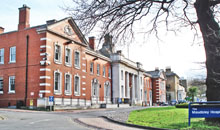
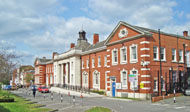
The original Hospital buildings on Denmark Hill, now used for administration, as seen from the north (left) and the south (right).
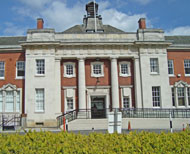
The portico bears the legend in gold 'The Maudsley Hospital'.
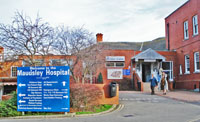

Just to the north of the administration building lies the main entrance to the Hospital campus (left), with the Out-Patients building to the north of that, beside the grey-brick 103 Denmark Hill (right).
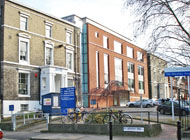
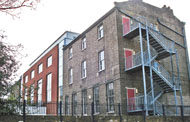
The front (left) and back (right) of No. 99 Denmark Hill and the newly built Centre for Neuroimaging Sciences, which opened in 2004. The Centre contains two MRI scanners, offices and laboratories.
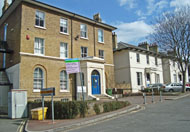

The fronts (left) and backs (right) of Nos. 111-113 Denmark Hill, housing various clinical departments. The buildings are to the south of the administration building.

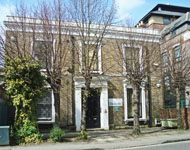
Douglas Bennett House (left) and 5 Windsor Walk, also home to clinical departments.
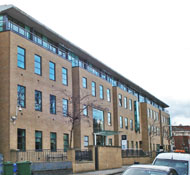
The David Goldberg Centre for Health Services Research and the Henry Wellcome Building for Psychology in De Crespigny Park are part of the Institute of Psychiatry and opened around 2000.
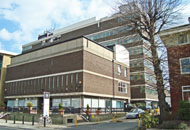
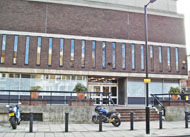
The Institute of Psychiatry was previously known as the Maudsley Hospital Medical School until 1948. The new building opened in 1967 and contains lecture theatres, a library, administrative offices and a restaurant. The main entrance is in De Crespigny Park.
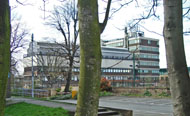
The Institute of Psychiatry, as seen from Grove Lane.
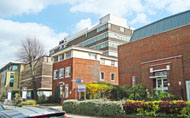
The Child Psychiatry Unit is located between the Institute of Psychiatry and the Michael Rutter Centre.
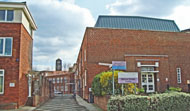
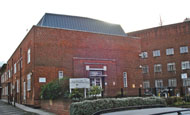
The Michael Rutter Centre for Children and Adolescents is named after Professor Sir Michael Rutter. It provides an out-patient service for children with mental health problems.
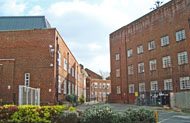
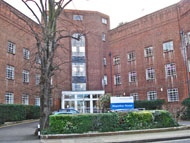
Mapother House, beside the Michael Rutter Centre in De Crespigny Park, is named after the first Medical Superintendent of the Hospital, Dr Edward Mapother (1881-1940), and is part of King's College Hospital. It was built in the 1990s.
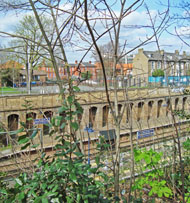
The Hospital, as seen from beyond Denmark Hill station.
Andrews J, Briggs A, Porter R and Tucker P 1997 The History of Bethlem Hospital. London, Routledge.
(Author unstated) 1911 Site for the proposed mental hospital. British Medical Journal 1 (2621), 716.
(Author unstated) 1916 Clearing hospitals. British Medical Journal 1 (2893), 831.
(Author unstated) 1917 The Maudsley Hospital. British Medical Journal 1 (2924), 51.
(Author unstated) 1917 List of the various hospitals treating military cases in the United Kingdom. London, H.M.S.O.
(Author unstated) 1918 The Maudsley Hospital. British Medical Journal 1 (2979), 162.
(Author unstated) 1918 Care of the wounded. British Journal of Nursing, 29th June, 454.
(Author unstated) 1923 Nursing echoes. British Journal of Nursing 70 , 212.
(Author unstated) 1937 The Maudsley Hospital, Denmark Hill. British Journal of Nursing 85, 36-37.
Curtis RH 1939 The Maudsley Hospital. Opening of new extension. British Medical Journal 2 (4098), 186-187
Jones E, Rahman S, Woolven R 2007 The Maudsley Hospital: Design and Strategic Direction, 1923-1939. Medical History 51, 357-387.
Russell D 1997 Scenes from Bedlam: A History of Caring for the Mentally Disordered at Bethlem Royal Hospital and The Maudsley. London, Butler and Tanner.
http://rcnarchive.rcn.org.uk
http://wapedia.mobi
www.geograph.org.uk
www.maudsleyredesign.co.uk
www.nursing.manchester.ac.uk
www.slam.nhs.uk
Return to home page